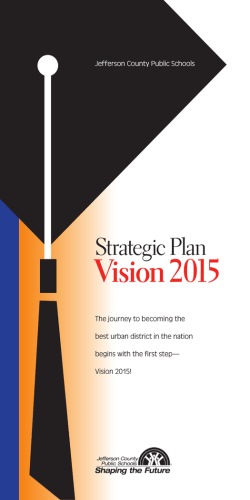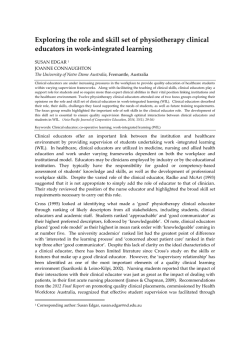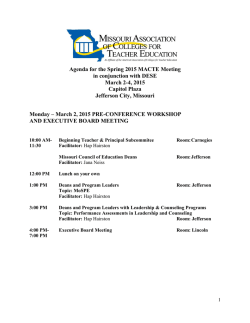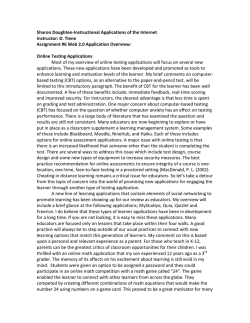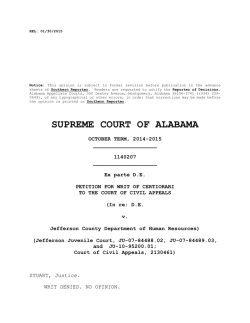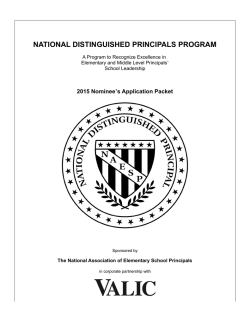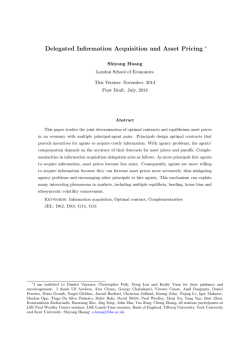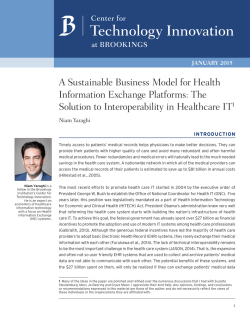
Goldhaber Testimony: Fixing No Child Left Behind remarks
U.S. Senate Committee on Health, Education, Labor, and Pensions Full Committee Hearing: Fixing No Child Left Behind: Supporting Teachers and School Leaders January 27, 2015 Written Statement of: Dr. Dan Goldhaber Director, National Center for Analysis of Longitudinal Data in Education Research at the American Institutes For Research Director, Center for Education Data and Research at the University of Washington, Bothell, WA Chairman Alexander, Ranking Member Murray, members of the committee, thank you for inviting me to testify today. My name is Dan Goldhaber and I am the director of the National Center for Analysis of Longitudinal Data in Education Research (CALDER) at the American Institutes for Research and the director of the Center for Education Data and Research at the University of Washington Bothell. I have been engaged in research on schools and student achievement for about 20 years, and much of my work focuses on the broad array of human capital policies that influence the composition, distribution, and quality of teachers in the workforce. Let me begin by saying that while these hearings are focused on fixing No Child Left Behind (NCLB), it is important to recognize that not all parts need fixing. The annual testing requirement of NCLB made possible a great deal of learning about the importance of the nation’s educators. Empirical evidence now clearly buttresses intuition that teachers differ significantly from one another in terms of their impacts on student learning and shows that these differences have long-term consequences for students’ later academic (Goldhaber and Hansen, 2010; Jackson and Bruegmann, 2009; Jacob and Lefgren, 2008; Kane and Staiger, 2008) and labor market (Chamberlain, 2013; Chetty et al., 2014; Jackson, 2013) success. There is also now good evidence that the quality of our educators has real implications for our nation’s long-term economic health (Hanushek, 2011).1 Research on school leaders is far less extensive, but it too suggests that principals, not surprisingly, significantly influence student achievement, in part by 1 Students’ success clearly depends a good deal on their experiences at home and in their neighborhoods, but teacher quality is arguably the most important schooling factor influencing academic outcomes (Goldhaber et al., 1999; Nye et al., 2002). AMERICAN INSTITUTES FOR RESEARCH | 1000 THOMAS JEFFERSON, NW | WASHINGTON, D.C. 20007 affecting the quality of teachers in their schools (Branch et al., 2012; Coelli and Green, 2012; Grissom and Loeb, 2011; Grissom et al., 2013). We also know that disadvantaged students tend to have less access to high quality teachers, whether the measure of quality is observable teacher credentials or studentgrowth (Clotfelter, et al. 2011; Goldhaber, et al. in press; Isenberg et al., 2013; Sass et al., 2012). This is problematic from an equity perspective in that public education is probably the single best social equalizer, offering opportunities for individuals to improve their socioeconomic status through hard work. A well-functioning education system can and should provide disadvantaged students with ways to escape poverty, but an unequal distribution of quality educators implies inequity in opportunity. A second overarching point is that information about individual educators’ needs is fundamental for informing teacher and school leader supports and for learning what policies and practices improve educator effectiveness. I am worried that a change we might see with reauthorization—a move away from a requirement of uniform statewide annual year-over-year testing—would greatly shrink and possibly even eliminate our knowledge of educator effectiveness, its distribution among students, and its responsiveness to different policies and practices. In short, it would greatly limit the information we need to make schools better. The reasons are simple. First, the right measure of the impacts of educators is one based on progress over time, not achievement at any given point. To be blunt, measures that do not track progress simply are not credible. And, second, we can compare the learning in one locality to another only when the yardstick measuring learning is the same in both. The most important educator policies are controlled by states—regulation of teacher education programs, licensure, induction and mentoring, tenure, layoffs, and often compensation. This suggests that states need solid information about educator outcomes, including impacts on student achievement, that are comparable across localities within a state to make good decisions about the policies that influence the entire teacher pipeline—from teacher preparation to the pay and status of in-service teachers to determining which teachers probably should not continue in the classroom. So what do we know about supporting teachers and leaders? While many might naturally think about “support” in connection to incumbent educators, I take a more expansive view: support also includes pre-service education and policies and practices aimed at attracting and retaining high-quality educators.2 In outlining the research here, l’ll cover three broad categories: 1) teacher preparation, 2) professional development and incentives, 3) recruitment, retention, and the distribution of teachers. Then I will close with a few thoughts about what this research suggests about fixing NCLB. 2 Nearly all the research I describe below is about teachers because there is relatively little quantitative work on the development and mobility of school leaders. AMERICAN INSTITUTES FOR RESEARCH | 1000 THOMAS JEFFERSON, NW | WASHINGTON, D.C. 20007 Teacher preparation Pre-service teacher training is thought to have a powerful influence on teacher career paths and student achievement (Levine, 2006; NCATE, 2010). Yet, there is very little empirical evidence linking pre-service training to workforce outcomes (National Research Council, 2010). A primary reason is that there are few localities where one can connect detailed information about the pre-service education experiences of prospective educators to their in-service workforce outcomes. Hence, much of the evidence on preservice preparation focuses on how a teacher enters the profession, i.e. via training in a college or university setting or through an alternative certification route (e.g. Constantine et al., 2009; Glazerman et al., 2006; Papay et al., 2012; Xu et al., 2011), or whether there are differences in effectiveness associated with the specific teacher education program attended (Boyd et al., 2009; Goldhaber et al., 2013; Goldhaber and Cowan, 2014; Mihaly et al., 2013; Koedel et al., forthcoming). The literature referenced here on pathways into the profession suggests that shorter programs with varying selection criteria and a practical teaching curriculum can produce graduates that are, on average, as effective as graduates from traditional college and university teacher-education programs. However, we do not know the extent to which this finding reflects differences in potential teachers’ backgrounds (i.e., who is selected into a program or pathway) versus differences in potential educators’ experiences in programs.3 Only a few studies connect the features of teacher training to the outcomes of teachers in the field. That said, evidence is mounting that some types of pre-service teaching experiences and pedagogical coursework are associated with better teacher outcomes. Some research shows, for instance, that teachers tend to be more effective when their student teaching experiences are well-aligned with their methods coursework (Boyd et al., 2009). There is also evidence that teacher trainees who student-teach in higher functioning schools (as measured by low attrition) turn out to be more effective teachers when responsible for their own classrooms (Ronfeldt, 2012). Novice teachers with better preparation in student teaching and methods coursework are also more likely to remain in the profession (Ronfeldt et al., 2014). To my knowledge, only one study connects principals’ training to student outcomes (Clark et al., 2009), and it doesn’t substantiate a relationship between the two.4 Taken together, studies like these begin to point toward ways to improve teacher preparation. But with such a thin evidentiary base, we are just beginning to understand what makes teacher preparation effective – both the criteria determining selection into 3 See Goldhaber (2013) for a more detailed review and discussion of selection versus training effects. The study does, however, find a positive relationship between principals’ years of experience and having previously served as an assistant principal, and student achievement. 4 AMERICAN INSTITUTES FOR RESEARCH | 1000 THOMAS JEFFERSON, NW | WASHINGTON, D.C. 20007 preparation programs and the education that teacher candidates receive. With roughly 200,000 newly minted teachers entering the profession each year, we need to know more. Professional development and incentives Nearly all school districts use professional development (PD) to try to improve teaching. Not surprisingly, therefore, a large number of studies relate both the content and mode of delivery of PD to teacher instructional practices and effectiveness. Unfortunately, most research on PD is not terribly rigorous, and few studies suggest that it systematically improves teaching.5 Several large-scale, well-designed, federally funded experimental studies do tend to confirm that PD has little or mixed impacts on student achievement. For instance, a randomized control trial focusing on a one-year content-focused PD program showed positive impacts on teachers’ knowledge of scientifically based reading instruction and instructional practices promoted by the PD program, but no discernable effects on student test scores (Garet et al., 2008). And another recent randomized control trial (Glazerman et al., 2010) of the effects of mentoring and induction (a form of profession development for novice teachers) did find some evidence that students of teachers who received two years of comprehensive induction had higher achievement levels by the third year. One argument for professional development’s relatively poor showing is that it is rarely targeted to the needs of individual educators. As for why, old-style “drive by” evaluations generally yielded little useable information about what individual teachers and leaders need. This was perhaps best captured in The Widget Effect (Weisburg et al., 2009), a study of twelve school districts (in four states) that showed that while the frequency and methods of teacher evaluation varied, the results of evaluations rarely did—nearly all teachers got a top performance rating.6 If all are judged to be the same, targeting professional development to their diverse needs is difficult indeed.7 Another way that policymakers have tried to improve educator effectiveness is by providing explicit incentives for teacher performance. Unfortunately, much of the highest quality randomized control trial evidence on this avenue of reform also suggests that it has limited impacts on student achievement (Yuan et al., 2013). One experiment (Marsh et al., 2011) showed that $3,000 bonuses for every teacher in a given school meeting 5 See, for instance, Yoon et al. (2007) for a comprehensive review. For rigorous studies of PD using longitudinal observational data, see, for instance, Harris and Sass (2011) and Jacob and Lefgren (2004). The most encouraging research on PD suggests that focusing on how students learn a content area tends to be more effective than PD emphasizing pedagogy/teaching behaviors or curriculum (Cohen and Hill, 2000; Kennedy, 1998; Rice, 2009). 6 Other evidence includes Bridges and Gumport (1984); Tucker (1997). 7 One might also argue that PD would be more likely to pay off under institutional structures that reward performance; teachers generally have little besides goodwill at stake when investing their time in professional development since they are simply satisfying PD seat time requirements (Rice, 2009). AMERICAN INSTITUTES FOR RESEARCH | 1000 THOMAS JEFFERSON, NW | WASHINGTON, D.C. 20007 performance standards had no impact on student achievement relative to control-group schools ineligible for the bonus. Another randomized control trial study (Springer et al., 2010) focused on teacher-level incentives of up to $15,000 per teacher also found no consistently significant difference between the outcomes of students with teachers in the treatment versus the control group.8 The most encouraging evidence about changing the effectiveness of in-service teachers comes from programs that take a more holistic approach, combining comprehensive evaluation with feedback, professional development and performance incentives.9 You heard last week from Tom Boasberg, the Superintendent of Denver Public Schools (DPS), about the progress the district has made over the last decade using such an approach.10 Findings from a study (Dee and Wyckoff, 2013) of the IMPACT system here in the District of Columbia show that teachers deemed highly effective (based on a multifaceted performance evaluation system) and eligible to receive large base pay increases if the high rating continue, increase their performance in the next year.11 Recruitment, retention, and the distribution of teachers As noted above, teacher quality is inequitably distributed across students. This finding is related to both the recruitment and retention patterns of teachers--not surprising since research shows that schools serving disadvantaged students face greater challenges hiring new teachers (Boyd et al., 2013; Engel et al., forthcoming) and that teachers are more likely to leave schools serving disadvantaged students for other schools or other professions (Borman and Dowling, 2008; Goldhaber et al., 2011; Hanushek et al., 2004; Scafidi et al., 2007). There is evidence that teachers making employment choices respond, as would be expected.12 Studies of recruitment incentives, for instance, find that offering bonuses increases the likelihood that teachers will take a position in schools offering the incentive. 8 One argument for the mixed evidence of pay for performance is that many performance plans are not well designed (Imberman and Lovenheim, 2014). The most encouraging experimental evidence on pay for performance in U.S. schools comes from a recent study by Fryer et al. (2012) with a very different study design from those described above. Teachers in a treatment group received a bonus up-front and were told that they would lose it if their students did not make significant test score gains, testing whether they might respond more to loss aversion than the potential for financial gain. In this case, student achievement in the performance-incented group was higher than in the control group. It is unlikely that this sort of incentive could be widely implemented given political and cultural constraints in public schools, but the finding does show the potential for policies to affect the effectiveness of the current teacher workforce. 9 Indeed there is evidence (Taylor and Tyler, 2012) that targeted feedback about teacher performance itself helps teachers become more effective. 10 My research with a colleague (Goldhaber and Walch, 2012) confirms these findings in Denver. 11 The study also finds that teachers at risk for termination for poor performance tend to either improve or voluntarily leave the district. 12 For a more comprehensive review, see Hanushek and Rivkin (1997). AMERICAN INSTITUTES FOR RESEARCH | 1000 THOMAS JEFFERSON, NW | WASHINGTON, D.C. 20007 Glazerman et al. (2013) study an experiment in which high-performing teachers are offered $20,000 bonuses to transfer to a low-achieving school for at least two years and find large recruitment effects. Steele et al. (2010) study a policy that provides prospective teachers with a $20,000 scholarship for teaching in a low-performing school for four years and get much the same result. Of course, the design of these financial incentives is also important: these policies do not provide ongoing inducements to stay in high-needs schools and neither study found evidence that targeted teachers stayed at high-needs schools longer. Much of the empirical evidence does show that higher permanent salaries reduce teacher attrition. Much of this evidence comes from investigating differences in salaries between districts in the same geographical area (e.g. Hanushek et al. 2004; Imazeki, 2005; Lankford, et al. 2002). Of particular note is research on retention incentives for schools serving high-poverty and low-achieving schools. Studying a program that awarded $1,800 bonuses to math, science, and special education teachers in high-poverty schools, Clotfeler et al. (2008) find that the bonus policy reduced the turnover of targeted teachers by about 17%. Springer et al. (2014) assess a program providing highly rated teachers in low-achieving schools $5,000 bonuses and find that the bonus improved teacher retention by 10-20%. But while financial incentives appear to be a viable tool for affecting the distribution of teachers, teachers clearly also care about their working conditions. Such factors as the quality of school leadership and workplace collegiality also affect teachers’ decisions and some scholars (Boyd et al., 2011; Johnson et al., 2012; Ladd, 2009) suggest that such factors matter far more than salary in determining whether teachers choose to teach in a particular school. This finding poses a challenge since there is not a direct policy control over such working conditions.13 Fixing No Child Left Behind Given current research, what is the connection between supporting a high quality teacher and school leader workforce and fixing No Child Left Behind? First consider that the NCLB testing requirement ushered in a new era: we now pay far more policy and research attention to the effects of schools and educators on student learning – an outcome focus – rather than making judgments about the quality of education students receive, or the equity of educational resources, based on schooling inputs (class size, teacher credentials, etc.). The shift has been significant and, to my mind, appropriate. Parents should care more about how much their students are learning in schools than, for 13 It is of course possible that policies could have impacts on school leadership or culture, but this would be more circuitous. For instance, one might require principals receive training to improve their leadership skills, but for it to have an impact on teachers, the training would have to change the perceptions that teachers have of a principal’s leadership skills. AMERICAN INSTITUTES FOR RESEARCH | 1000 THOMAS JEFFERSON, NW | WASHINGTON, D.C. 20007 instance, about teachers’ specific backgrounds and educational credentials (though the two may certainly be related). This new focus on educational outputs means that any changes to NCLB should preserve our ability to garner accurate information about the outputs of teachers and school leaders. Here I echo my initial point that this information is key to determining what kind of support individual teachers and leaders need so they can improve, which leaders and teachers we want to stay in public schools, and what policies and practices lead to improvements in educator effectiveness. To be sure, states left to their own devices might decide to continue with a testing system that allows for credible information across localities in educator effectiveness. Recall here that in the decade or so before NCLB passed, only a handful of states had year over year testing of all students. My fear is that, given the difficult politics associated with testing, many states would return to systems that would not permit measures of student growth that are comparable across school systems in a state. I’ll end by touching on a final issue about the federal role in influencing the effectiveness of the nation’s educators. While NCLB has been in place for well over a decade, the national focus on effectiveness of individual educators, and the institutions that prepare them, is far more recent. The country is in the midst of a large experiment in reforming the way educators are evaluated. Just since 2009, 49 states and the District of Columbia have changed their evaluation systems, and in many cases these changes are being fully implemented only now (Center on Great Teachers and Leaders, 2014). Many of these changes entail using information on individual educators to inform important policies (e.g., regarding teacher preparation) and personnel decisions (compensation, professional development, tenure, licensing, etc.), and, as noted above, new evidence shows that this can make a difference for educator effectiveness. But we are now just on the cusp of learning about how these changes affect the quality of the educator workforce and sound policy must rest on such knowledge. Throughout I have emphasized a focus on information on the effectiveness of individual educators. This is appropriate given what we have learned over the last decade about the important variation in effectiveness between teachers and school leaders, and because most states now have policies designed to act on what we learn about educator effectiveness. However, I very much doubt that we would have seen much state experimentation with pre-service and in-service policies were it not for the role of the federal government in incenting such change. I think we can do better when it comes to supporting teachers and school leaders, and learn more about the policies and practices that result in a more effective educator workforce. But significant improvements will require more innovation, and the federal government can play an important role in nudging, not mandating, states and localities to innovate (for instance in the realm of AMERICAN INSTITUTES FOR RESEARCH | 1000 THOMAS JEFFERSON, NW | WASHINGTON, D.C. 20007 teacher preparation) through competitive grant programs, like the Teacher Incentive Fund, that encourage experimentation with the systems and institutions that govern the teacher pipeline. The public education enterprise has to get smarter about how to deliver education, and figuring out how to improve educator effectiveness is arguably the best way to improve the future of the nation’s children. References Aaronson, D., Barrow, L., & Sander, W. (2007). Teachers and student achievement in the Chicago Public High Schools." Journal of Labor Economics 25, no. 1 (2007): 95-135. Borman, G & Dowling, N. (2008). Teacher attrition and retention: A meta-analytic and narrative review of the research. Review of Educational Research, 78(3), 367–409. Boyd, D., Grossman, P., Lankford, H., Loeb, S., & Wyckoff, J. (2008). Who Leaves? Teacher Attrition and Student Achievement. Cambridge, MA: National Bureau of Economic Research. Boyd, D., Grossman, P., Ing, M., Lankford, H., Loeb, S., & Wyckoff, J. (2011). The influence of school administrators on teacher retention decisions. American Educational Research Journal, 48, 303–333. Branch, G. F., Hanushek, E. A., & Rivkin, S. G. (2012). Estimating the effect of leaders on public sector productivity: The case of school principals. Cambridge, MA: National Bureau of Economic Research. Bridges, E. & Gumport, P. (1984). The dismissal of Tenures Teachers for Incompetence. Stanford, CA: Institute for Research on Educational Finance and Governance, 1984. Technical Report. Center on Great Teachers and Leaders State Evaluation Policy Database (2014). Retrieved on 1/24/2015 from http://resource.tqsource.org/stateevaldb/ Chamberlain, G. (2013). Predictive effects of teachers and schools on test scores, college attendance, and earnings. Proceedings of the National Academy of Sciences, 110(43), 17176–17182. Chetty, R., Friedman, J. N., & Rockoff, J. E. (2014). Measuring the Impacts of Teachers II: Teacher Value-Added and Student Outcomes in Adulthood. American Economic Review, 104(9), 2633–2679. Clark, D., Mortorell, P. & Rockoff, J. (2009). School principals and school performance. CALDER Working Paper 38. AMERICAN INSTITUTES FOR RESEARCH | 1000 THOMAS JEFFERSON, NW | WASHINGTON, D.C. 20007 Clotfelter, C., Glennie, E., Ladd, H., & Vigdor,J. (2008). Would higher salaries keep teachers in high-poverty schools? Evidence from a policy intervention in North Carolina. Journal of Public Economics, 92:5, pp. 1352-1370. Clotfelter, C., Ladd, H., & Vigdor, J. (2010). Teacher credentials and student achievement in high school: a cross subject analysis with fixed effects"." Journal of Human Resources 45: 655-681. Clotfelter, C. T., Ladd, H. F., & Vigdor, J. L. (2011). Teacher mobility, school segregation, and pay-based policies to level the playing field. Education Finance and Policy, 6(3), 399–438. Coelli, M. & Green, D.A. (2012). Leadership effects: school principals and student outcomes. Economics of Education Review 31(1), 92-109. Cohen, D. & Hill, H. (2000). Instructional policy and classroom performance: The mathematics reform in California. Teachers College Record, 102(2), 294–343. Constantine, J., Player, D., Silva, T., Hallgren, K., Grider, M., & Deke, J. (2009). An evaluation of teachers trained through different routes to certification. Final Report for National Center for Education and Regional Assistance, 142. Dee, T. S. & Wyckoff, J. (2013). Incentives, selection, and teacher performance: Evidence from IMPACT. CALDER Working Paper 102. Engel, M., Jacob, B., & *Curran, F.C. (forthcoming) New Evidence on Teacher Labor Supply. American Educational Research Journal–Social and Institutional Analysis Fryer, R., Levitt, S., List, J., & Sadoff, S. (2012). Enhancing the Efficacy of Teacher Incentives through Loss Aversion: A Field Experiment. NBER Working Paper No. 18237. Fulbeck, E. S. (2014). Teacher Mobility and Financial Incentives: A Descriptive Analysis of Denver’s ProComp. Educational Evaluation and Policy Analysis, 36(1), 67–82. Garet, M.S., Cronen, S., Eaton, M., Kurki, A., Ludwig, M., Jones, W., Uekawa, K., Falk, A., Bloom, H.S., Doolittle, F., Zhu, P., & Sztehjnberg, L. (2008). The impact of two professional development interventions on early reading instruction and achievement." American Institutes for Research and MDRC. NCEE 2008-4030. Glazerman, S., Mayer, D., & Decker, P. (2006). Alternative routes to teaching: The impacts of Teach for America on student achievement and other outcomes. Journal of Policy Analysis and Management, 25(1), 75-96. AMERICAN INSTITUTES FOR RESEARCH | 1000 THOMAS JEFFERSON, NW | WASHINGTON, D.C. 20007 Glazerman, S. Protik, A., Teh, B., Bruch, J., & Max, J. (2013). Transfer incentives for high-performing teachers: final results from a multisite randomized experiment (NCEE2014-4033) . Washington, DC: National Center for Education Evaluation and Regional Assistance, Institute of Education Sciences, U.S. Department of Education. Glazerman, S. and Seifullah, A. (2010). An evaluation of the Teacher Advancement Program (TAP) in Chicago: Year two impact report. Mathematica Policy Research. Goldhaber (2013). What do value-added measures of teacher preparation programs tell us? Carnegie Knowledge Network Knowledge Brief. Published online at http://www.carnegieknowledgenetwork.org/briefs/teacher_prep/ Goldhaber, D., Brewer, D. & Anderson, D. (1999) A three-way error components analysis of educational productivity. Education Economics, 7(3), 199-208. Goldhaber, D., Gross, B., & Player, D. (2011). Teacher Career Paths, Teacher Quality, and Persistence in the Classroom: Are Public Schools Keeping Their Best? Journal of Policy Analysis and Management, 30(1), 57–87. Goldhaber, D., Lavery, L., & Theobald, R. (2014). Uneven Playing Field? Assessing the Teacher Quality Gap Between Advantaged and Disadvantaged Students. Educational Researcher, in press. Goldhaber, D. & Walch, J. (2012). “Strategic pay reform: a student outcomes-based evaluation of Denver’s ProComp teacher pay initiative.” Economics of Education Review, 31(6): 1067-1083. Grissom, J. A., & Loeb, S. (2011). Triangulating Principal Effectiveness: How Perspectives of Parents, Teachers, and Assistant Principals Identify the Central Importance of Managerial Skills. American Educational Research Journal, 48(5), 1091– 1123. Grissom, J. A., Loeb, S., & Master, B. (2013). Effective Instructional Time Use for School Leaders: Longitudinal Evidence From Observations of Principals. Educational Researcher, 42(8), 433–444. Hansen, M. (2009). How career concerns influence public workers' effort: Evidence from the teacher labor market. CALDER Working Paper #40 Hanushek, E. A. (2011). The economic value of higher teacher quality. Economics of Education Review, 30(3), 466–479. AMERICAN INSTITUTES FOR RESEARCH | 1000 THOMAS JEFFERSON, NW | WASHINGTON, D.C. 20007 Hanushek, E. & Rivkin, S. (2007). Pay, working conditions and teacher quality. Future of Children, 17(1), 69-86. Harris, D. & Sass, T. (2011). Teacher training, teacher quality, and student achievement. Journal of Public Economics, 95, 7-8: 798-812. Hill, H.C., Umland, K. L. & Kapitula, L.R. (2011). A validity argument approach to evaluating value-added scores. American Educational Research Journal 48, 794-831. Ichniowski, C. & Shaw, K. (2003). Beyond incentive pay: Insiders' estimates of the value of complementary human resource management practices. The Journal of Economic Perspectives 17(1), pp. 155-180. Imazeki, J. (2005). Teacher salaries and teacher attrition. Economics of Education Review, 24(4), 431–449. Imberman, S. & Lovenheim, M. (2014). Incentive strength and teacher productivity: evidence from a group-based teacher incentive pay system. The Review of Economics and Statistics. Published online at http://www.mitpressjournals.org/doi/abs/10.1162/REST_a_00486#.VMP2sHYeVjU Ingersoll, R. & Strong, M. (2011). The impact of induction and mentoring programs for beginning teachers. Review of Educational Research 81:2, pp. 201-233. Isenberg, E., Max, J., Gleason, P., Potamites, L., Santillano, R., Hock, H., & Hansen, M. (2013). Access to effective teaching for disadvantaged students (NCEE 2014-4001). Washington, DC: National Center for Education Evaluation and Regional Assistance, Institute of Education Sciences, U.S. Department of Education. Jackson, C. (2013) "Non-Cognitive Ability, Test Scores, and Teacher Quality: Evidence from 9th Grade Teachers in North Carolina", NBER Working Paper No. 18624. Jackson, C. & Bruegmann, E. (2009). Teaching students and teaching each other: the importance of peer learning for teachers." American Economic Journal: Applied Economics 1(4): 85–108. Jacob, B. & Lefgren, L. (2004). The impact of teacher training on student achievement. Journal of Human Resources, 39:1, pp. 50-79. Jacob, B. & Lefgren, L. (2008). Can principals identify effective teachers? Evidence on subjective evaluation in education. Journal of Labor Economics 26 (1), 101–136. Johnson, S., Kraft, M., & Papay, J. (2012). How Context Matters in High-Need Schools: AMERICAN INSTITUTES FOR RESEARCH | 1000 THOMAS JEFFERSON, NW | WASHINGTON, D.C. 20007 The Effects of Teachers’ Working Conditions on Their Professional Satisfaction and Their Students. Teachers College Record Volume 114 Number 10, 2012, p. 1-39 http://www.tcrecord.org ID Number: 16685, Date Accessed: 1/24/2015 2:48:06 PM Kane, T. & Staiger, D. O. (2008) Estimating teacher impacts on student achievement: An experimental evaluation. Cambridge, MA, NBER. Kennedy, M. (1998) Form and substance in teacher inservice education, Research Monograph No. 13 (Madison, WI, National Institute for Science Education, University of Wisconsin-Madison). Koedel, C., Parsons, E., Podgursky, M. & and Ehlert, M. (forthcoming). Teacher preparation programs and teacher quality: are there real differences across programs? Education Finance and Policy. Lankford, H., Loeb, S., & Wyckoff, J. (2002). Teacher sorting and the plight of urban schools: A descriptive analysis. Educational Evaluation and Policy, 24(1), 37–62. Levine, Arthur. (2006). Educating School Teachers. The Education Schools Project. Marsh, J., Springer, M., McCaffrey, D., Yuan, K., Epstein, S., Koppich, J., Kalra, N., DiMartino, C., & Peng, A. (2011). A big apple for educators: New York City’s experiment with schoolwide performance bonuses. RAND Corporation. Mihaly, K., McCaffrey, D., Sass, T. R., & Lockwood, J. R. (2013). Where You Come From or Where You Go? Distinguishing Between School Quality and the Effectiveness of Teacher Preparation Program Graduates. Education Finance and Policy, 8(4), 459– 493. Murnane, R., Singer, J., Willett, J., Kemple, J., & Olsen, R. (Eds.). (1991). Who will teach?: Policies that matter. Cambridge, MA: Harvard University Press. National Council for Accreditation of Teacher Education. (2010). Transforming Teacher Education Through Clinical Practice: A National Strategy to Prepare Effective Teachers. Report of the Blue Ribbon Panel on Clinical Preparation and Partnerships for Improved Student Learning. National Research Council. (2010). Preparing teachers: Building evidence for sound policy. Committee on the Study of Teacher Preparation Programs in the United States. Washington, DC: National Academies Press. Nye, B., Konstantopoulos, S. & Hedges, L.V. (2004). How large are teacher effects? Educational Evaluation and Policy Analysis 26:3, 237-257. AMERICAN INSTITUTES FOR RESEARCH | 1000 THOMAS JEFFERSON, NW | WASHINGTON, D.C. 20007 Papay, J.P., West, M.R., Fullerton, J.B., & Kane, T.J. (2012). Does an urban teacher residency increase student achievement? Early evidence from Boston. Educational Evaluation and Policy Analysis 34(4), 413-434. Rice, J. (2009). Investing in human capital through teacher professional development. In Goldhaber, D. and Hannaway, J., ed. Creating a New Teaching Profession. The Urban Institute. Rivkin, S., Hanushek, E. & Kain, J. (2005) Teachers, schools, and academic achievement. Econometrica, 73(2), 417-458. Rockoff, J. (2004) The impact of individual teachers on students' achievement: Evidence from panel data. American Economic Review, 94(2), 247-252. Ronfeldt, M. (2012). Where should student teachers learn to teach? Effects of field placement school characteristics on teacher retention and effectiveness. Educational Evaluation and Policy Analysis, 34(1), 3-26. Ronfeldt, M., Schwartz, N., & Jacob, B. (2014). Does pre-service preparation matter? Examining an old question in new ways. Teachers College Record 116(10), 1-46. Sass, T. R., Hannaway, J., Xu, Z., Figlio, D. N., & Feng, L. (2012). Value added of teachers in high-poverty schools and lower poverty schools. Journal of Urban Economics, 72(2-3), 104–122. Scafidi, B., Sjoquist, D. & Stinebricker, T. (2007). Race, poverty, and teacher mobility. Economics of Education Review, 26(2), 145-159. Springer, M., Hamilton, L., McCaffrey, D., Ballou, D., Le, V., Pepper, M., Lockwood, JR, & Stecher, B. (2010). Teacher pay for performance: experimental evidence from the project on incentives in teaching. National Center on Performance Incentives Working Paper, Vanderbuilt University, Nashville, TN. Springer, M. G., Rodriguez, L. A., & Swain, W. A. (2014). Effective teacher retention bonuses: Evidence from Tennessee. Nashville, TN: Tennessee Consortium on Research, Evaluation, and Development. Steele, J., Murnane, R., & Willett, J. (2010). Do financial incentives help low-performing schools attract and keep academically talented teachers? Evidence from California. National Bureau of Economic Research Working Paper 14780. Taylor, E. & Tyler, J. 2012. The effect of evaluation on teacher performance. American Economic Review, 102(7): 3628-51. Tucker, P. (1997). Lake Wobegon: Where all teachers are competent (or, have we come to terms with the problem of incompetent teachers?) Journal of Personnel Evaluation in Education 11:103-126. AMERICAN INSTITUTES FOR RESEARCH | 1000 THOMAS JEFFERSON, NW | WASHINGTON, D.C. 20007 Weisberg, D., Sexton, S., Mulhern, J. & Keeling, D. (2009). The widget effect: Our national failure to acknowledge and act on differences in teacher effectiveness. New York, NY: The New Teacher Project. Yoon, K. S., Duncan, T., Lee, S. W.-Y., Scarloss, B., & Shapley, K. (2007). Reviewing the evidence on how teacher professional development affects student achievement (Issues & Answers Report, REL 2007–No. 033). Washington, DC: U.S. Department of Education, Institute of Education Sciences, National Center for Education Evaluation and Regional Assistance, Regional Educational Laboratory Southwest. Retrieved from http://ies.ed.gov/ncee/edlabs. Yuan, K, Le, V, McCaffrey, D.F., Marsh, J.A., Hamilton, L.S., Stecher, Brian M., & Springer, M.G. (2013). Incentive Pay Programs Do Not Affect Teacher Motivation or Reported Practices Results From Three Randomized Studies. Educational Evaluation and Policy Analysis. 35(1), 3–22. Xu, Z., Hannaway, J., and Taylor, C. (2011). Making a difference? The effects of Teach For America in high school. Journal of Policy Analysis and Management. Vol 30(3), 447–469. ### AMERICAN INSTITUTES FOR RESEARCH | 1000 THOMAS JEFFERSON, NW | WASHINGTON, D.C. 20007
© Copyright 2025
![1 [Billing Code: 4140-01-P] DEPARTMENT OF HEALTH AND](http://s2.esdocs.com/store/data/000481678_1-ace6079cd3a136722e5d2fb9067d8877-250x500.png)
